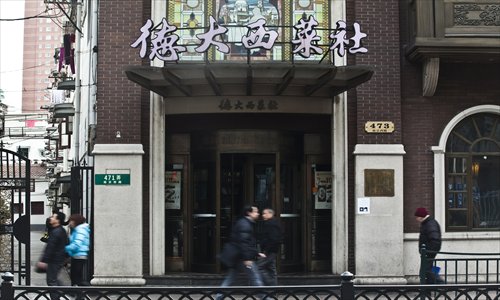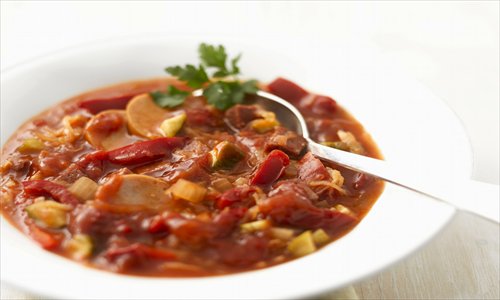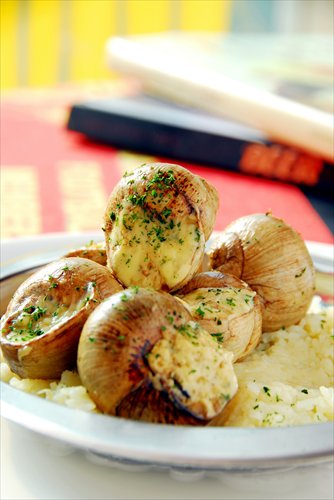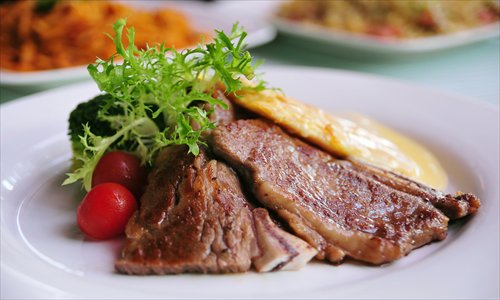HOME >> METRO SHANGHAI
Foreign flavors
By Liao Fangzhou Source:Global Times Published: 2014-2-27 18:23:01
Editor's note
From a fishing village with a population of just 200,000 in 1843, Shanghai has developed into a huge modern city where more than 23 million people live. From the time Shanghai was forced to open up as a port in 1843, the city has witnessed remarkable change and progress. This year marks the 171st anniversary of Shanghai's opening-up and in this special series of reports, the Global Times will highlight some of the crucial moments, recall some choice memories of olden days and uncover some of the secrets of the city. Don't miss these exciting insights into the metropolis.

The Italian missionary Lazzaro Cattaneo arrived in Shanghai in 1608 and introduced local believers to communion wine and bread. This was probably the first taste of international cuisine offered in the city but after Shanghai was opened up as a port in 1843, cooks from Britain, the US, France, Italy and Russia began setting up their own restaurants, bars, and cafés featuring their own foods.
One of the first of the foreign foods to prove a hit in town was the pecan and coconut cake at the Italian Club. Food writer Zhou Fenna called it the "must-try dessert" in her essay on the origins of Western food in old Shanghai.
Other cuisines followed as Western hotels, like Astor House and the Palace Hotel on the Bund, began offering Western menus between 1850 and 1875. In 1883 independent restaurants and cafés came into being as the downtown saw a number of new eateries offering smaller menus and quicker service opened. The English restaurant Sullivan's was one of these.
At Sullivan's, according to Shanghai writer Qin Shouou, a 1 or 2 silver dollars set menu included a soup, a fish (or shellfish) entree, a main course, a small cup of coffee and a dessert. Bread was free and unlimited. This was certainly not cheap - during 1926 and 1936, one could buy 8 kilograms of rice or 2 kilograms of pork for that price.
By 1925 there were 41 Western restaurants in Shanghai. When the citywide Western Food Industry Association was established in July 1931, there were more than 150 Western eating houses. Foochow Road (now Fuzhou Road) and Avenue Joffre (now Huaihai Road Middle) were home to many.

Russian tastes
Nowadays the city has only a couple of Russian restaurants but during the early part of the 20th century Russian cuisine accounted for a large part of the Western dining scene. After the October Revolution in 1917, many White Russians fled and settled in Shanghai, some choosing to support themselves by opening (usually small) restaurants, mostly on Avenue Joffre. By the end of 1920s, there were 40 or so Russian restaurants in the city.
The Russian eateries, in general, were considerably cheaper than French restaurants and more approachable. In a letter from the poet and writer Zhu Ziqing to the prominent writer and publisher Ye Shengtao in 1931, Zhu recalled a Russian restaurant meal in Shanghai in 1930 and ascribed the restaurant's popularity to it being not only affordable but also that many of the dishes were cooked in oil (catering to the tastes of the Chinese) and easy to share.
Among the more popular Russian bistros was Donghua, to the west of a cinema then called the Paris Grand Theatre (later it became the Huaihai Cinema) on Avenue Joffre. For just 6 old silver cents, a customer could have an unlimited supply of Russian bread alongside a bowl of borscht soup topped with fresh cream.
Laodachang was another hot spot on Avenue Joffre and it specialized in Russian bread. Eileen Chang, who frequented this bakery, which was near her school, fondly described its offerings in a 1988 essay on food. She was especially fond of a small bun with a hot cross on the base and a cheese filling and described the "slightly salty" taste as "subtle and delicious."
As well as cheap eateries there were also some classy Russian restaurants. In the middle of Avenue Joffre, according to the food critic and writer Duo Qiao, there was the Noble Constantine where the waiters wore black Turkish gowns and yellow silk jackets, which led many to nickname the restaurant the "Yellow Jacket."

A French romance
One of the classic restaurants of the old Shanghai Western dining experience was Chez Rovere. The owner, an Italian named Louis Rovere, used to work at the Astor House and there he wooed a French woman who was staying at the hotel. After they got married in 1935, they opened this French restaurant (though they included a few Italian dishes).
A great location helped the restaurant bloom. It was right next to the French Club and the menus were a delight too. The classic French onion soup was a Chez Rovere signature dish and proved to be a hit. Eileen Chang, who was a regular here, enjoyed this, as was discovered by one of the order books she kept. Alongside the onion soup Chang ordered escargots and mustard marinated steak, both trademark dishes of the restaurant. According to the magazine Travel + Leisure, there was a time when Shanghai ran out of snails and Rovere had to replace them with clams. The adapted recipe was a success in Shanghai and later even became popular back in France.
Because he was Jew Rovere was thrown into an internment camp in 1941 after the Japanese took power in the then French Concession. After he was freed and reunited with his wife in 1945, they reopened their restaurant at 37 Avenue du Roi Albert (now Shaanxi Road South) and called it the Chez Louis Bar. The new eatery stood out with its bright red bricks exterior which led regular diners, mostly from industrial and commercial professions, to dub it "hong fangzi" (the Red House). The nickname quickly spread and became synonymous with the restaurant.
A German restaurant, Cosmopolitan Restaurant (now the Deda Western Food Restaurant), opened at 177 Boone Road (today's Tanggu Road) in Hongkou in 1897 and proved a hit with the city folk. The restaurant offered homemade ham and bacon, and featured dishes included potato salad, fried pork chops, and their special German steaks.
The steaks here were rare and juicy - even when customers asked for "well- done" they would often find their meat was bloody on the inside. Though this could be a somewhat daunting experience for Chinese who were used to food being thoroughly cooked and the restaurant often ended up with a lot of leftover food thanks to the generous portions, locals seemed to appreciate the foreign touches and helped keep the business thriving, noted food writer Zhou Fenna.
Most of its customers were expats, managers, bank clerks, and journalists who worked nearby. In 1946, the restaurant relocated to 359 Sichuan Road Middle. According to the Xinmin Evening News, this was a very popular place for dates and many young Shanghai children first learned how to use a knife and fork here.

Chinese versions
The Chinese were not left behind as Western food became a business. Some of those who had worked as chefs on international ships or in foreign banks in the late 19th century, opened restaurants with Western-style dishes that, through their adaptations, catered to those who were eager and curious to try foreign dishes but were uncomfortable with the real thing.
One well-known restaurant of this kind was Yipinxiang on Fuzhou Road. In Sun Jiazhen's 1898 novel Haishang Fanhua Meng (Splendid is the Shanghai Dream), which revolves around Shanghai brothels, many of the customers at the restaurant were prostitutes from nearby clubs and their clients.
The interior was furnished in a Western style and the tables were decorated with candles and fresh flowers, but a lot of the ingredients Yipinxiang used were Chinese - for example ham from the Zhejiang city Jinhua, and local seafood. According to the 1917 book Qingbai Leichao (Qing Trivia), at Yipinxiang a set dinner cost 1 silver dollar, an afternoon tea cost 70 silver cents, and an appetizer was 50 silver cents.
Also prospering was Jinlong on Nanjing Road. The chefs here came from the Zhejiang city Ningbo and they frequently introduced new dishes which proved popular with the more Westernized Chinese courtesans and dandies. Jinlong's unique dish of fried hairy crab (the Shanghai obsession) with cheese was highly acclaimed.
Another popular food haunt was Daxiyang at the corner of Foochow and Rue Palikao roads (today's Fuzhou and Yunnan roads). It became notorious in the 1930s and 1940s because three headline-grabbing murders occurred there. The victims were all leading mobsters: Lu Liankui, a brutal police captain and gang member, Gao Xinbao, triad boss Du Yuesheng's right-hand man, and gang leader Qiu Lianhuan, the owner of one of the most popular ballrooms in Shanghai at the time.
Try this at home
Meanwhile Western cooking started to enter Shanghai homes as many of the customers at the Western restaurants (especially trendy young women) sought to recreate their favorite dishes at home. From the 1920s, lifestyle magazines began to publish Western menus and meticulously described Western ingredients and cooking methods. Wealthy housewives began to follow the menus and cooking instructions, to make a variety of Western dishes for their guests.
One Western dish really caught on in Shanghai and became a staple in many city homes - borscht soup, although the local variation was not exactly the borscht served at Russian restaurants. While the Russians used beetroot and beef as a base and added cabbage, tomato, potato or celery, in Shanghai where there was no beetroot the main ingredients were tomato, cabbage, and potato. The taste of the Shanghai "borscht" was sweeter and sharper than the original and this appealed to local tastes. Some city cooks started adding sliced Chinese sausage to the soup and this became a popular form.
The popularity of Western cooking and Western dishes diminished after the Communist Party of China took power in 1949. The number of Western restaurants, for one thing, declined. In 1950 there were still 3,157 people working in 154 Western restaurants in Shanghai, by 1955 there were 1,352 people in 67 restaurants and by 1956 there were 54 restaurants. Daxiyang, which outlived Yipinxiang and Jinlong, finally closed this year.
From the 1960s, the lack of ingredients caused the industry to shrink further and by 1963 there were just 21 Western restaurants left. During the early years of the Cultural Revolution (1966-76), the number slumped to 13 with all of them changing their names and serving only Chinese food. In 1971, the Chez Louis Bar was the first to resume business and other restaurants gradually followed. In 1995, there were 105 Western restaurants. Today, the number exceeds 1,200.
From a fishing village with a population of just 200,000 in 1843, Shanghai has developed into a huge modern city where more than 23 million people live. From the time Shanghai was forced to open up as a port in 1843, the city has witnessed remarkable change and progress. This year marks the 171st anniversary of Shanghai's opening-up and in this special series of reports, the Global Times will highlight some of the crucial moments, recall some choice memories of olden days and uncover some of the secrets of the city. Don't miss these exciting insights into the metropolis.

The Deda Western Food Restaurant on Nanjing Road West continues its tradition of Western food. Photo: CFP
The Italian missionary Lazzaro Cattaneo arrived in Shanghai in 1608 and introduced local believers to communion wine and bread. This was probably the first taste of international cuisine offered in the city but after Shanghai was opened up as a port in 1843, cooks from Britain, the US, France, Italy and Russia began setting up their own restaurants, bars, and cafés featuring their own foods.
One of the first of the foreign foods to prove a hit in town was the pecan and coconut cake at the Italian Club. Food writer Zhou Fenna called it the "must-try dessert" in her essay on the origins of Western food in old Shanghai.
Other cuisines followed as Western hotels, like Astor House and the Palace Hotel on the Bund, began offering Western menus between 1850 and 1875. In 1883 independent restaurants and cafés came into being as the downtown saw a number of new eateries offering smaller menus and quicker service opened. The English restaurant Sullivan's was one of these.
At Sullivan's, according to Shanghai writer Qin Shouou, a 1 or 2 silver dollars set menu included a soup, a fish (or shellfish) entree, a main course, a small cup of coffee and a dessert. Bread was free and unlimited. This was certainly not cheap - during 1926 and 1936, one could buy 8 kilograms of rice or 2 kilograms of pork for that price.
By 1925 there were 41 Western restaurants in Shanghai. When the citywide Western Food Industry Association was established in July 1931, there were more than 150 Western eating houses. Foochow Road (now Fuzhou Road) and Avenue Joffre (now Huaihai Road Middle) were home to many.

Borscht soup inspires taste buds. Photo: IC
Russian tastes
Nowadays the city has only a couple of Russian restaurants but during the early part of the 20th century Russian cuisine accounted for a large part of the Western dining scene. After the October Revolution in 1917, many White Russians fled and settled in Shanghai, some choosing to support themselves by opening (usually small) restaurants, mostly on Avenue Joffre. By the end of 1920s, there were 40 or so Russian restaurants in the city.
The Russian eateries, in general, were considerably cheaper than French restaurants and more approachable. In a letter from the poet and writer Zhu Ziqing to the prominent writer and publisher Ye Shengtao in 1931, Zhu recalled a Russian restaurant meal in Shanghai in 1930 and ascribed the restaurant's popularity to it being not only affordable but also that many of the dishes were cooked in oil (catering to the tastes of the Chinese) and easy to share.
Among the more popular Russian bistros was Donghua, to the west of a cinema then called the Paris Grand Theatre (later it became the Huaihai Cinema) on Avenue Joffre. For just 6 old silver cents, a customer could have an unlimited supply of Russian bread alongside a bowl of borscht soup topped with fresh cream.
Laodachang was another hot spot on Avenue Joffre and it specialized in Russian bread. Eileen Chang, who frequented this bakery, which was near her school, fondly described its offerings in a 1988 essay on food. She was especially fond of a small bun with a hot cross on the base and a cheese filling and described the "slightly salty" taste as "subtle and delicious."
As well as cheap eateries there were also some classy Russian restaurants. In the middle of Avenue Joffre, according to the food critic and writer Duo Qiao, there was the Noble Constantine where the waiters wore black Turkish gowns and yellow silk jackets, which led many to nickname the restaurant the "Yellow Jacket."

Snails inspire taste buds. Photo: IC
A French romance
One of the classic restaurants of the old Shanghai Western dining experience was Chez Rovere. The owner, an Italian named Louis Rovere, used to work at the Astor House and there he wooed a French woman who was staying at the hotel. After they got married in 1935, they opened this French restaurant (though they included a few Italian dishes).
A great location helped the restaurant bloom. It was right next to the French Club and the menus were a delight too. The classic French onion soup was a Chez Rovere signature dish and proved to be a hit. Eileen Chang, who was a regular here, enjoyed this, as was discovered by one of the order books she kept. Alongside the onion soup Chang ordered escargots and mustard marinated steak, both trademark dishes of the restaurant. According to the magazine Travel + Leisure, there was a time when Shanghai ran out of snails and Rovere had to replace them with clams. The adapted recipe was a success in Shanghai and later even became popular back in France.
Because he was Jew Rovere was thrown into an internment camp in 1941 after the Japanese took power in the then French Concession. After he was freed and reunited with his wife in 1945, they reopened their restaurant at 37 Avenue du Roi Albert (now Shaanxi Road South) and called it the Chez Louis Bar. The new eatery stood out with its bright red bricks exterior which led regular diners, mostly from industrial and commercial professions, to dub it "hong fangzi" (the Red House). The nickname quickly spread and became synonymous with the restaurant.
A German restaurant, Cosmopolitan Restaurant (now the Deda Western Food Restaurant), opened at 177 Boone Road (today's Tanggu Road) in Hongkou in 1897 and proved a hit with the city folk. The restaurant offered homemade ham and bacon, and featured dishes included potato salad, fried pork chops, and their special German steaks.
The steaks here were rare and juicy - even when customers asked for "well- done" they would often find their meat was bloody on the inside. Though this could be a somewhat daunting experience for Chinese who were used to food being thoroughly cooked and the restaurant often ended up with a lot of leftover food thanks to the generous portions, locals seemed to appreciate the foreign touches and helped keep the business thriving, noted food writer Zhou Fenna.
Most of its customers were expats, managers, bank clerks, and journalists who worked nearby. In 1946, the restaurant relocated to 359 Sichuan Road Middle. According to the Xinmin Evening News, this was a very popular place for dates and many young Shanghai children first learned how to use a knife and fork here.

Pork chops inspire taste buds. Photo: IC
Chinese versions
The Chinese were not left behind as Western food became a business. Some of those who had worked as chefs on international ships or in foreign banks in the late 19th century, opened restaurants with Western-style dishes that, through their adaptations, catered to those who were eager and curious to try foreign dishes but were uncomfortable with the real thing.
One well-known restaurant of this kind was Yipinxiang on Fuzhou Road. In Sun Jiazhen's 1898 novel Haishang Fanhua Meng (Splendid is the Shanghai Dream), which revolves around Shanghai brothels, many of the customers at the restaurant were prostitutes from nearby clubs and their clients.
The interior was furnished in a Western style and the tables were decorated with candles and fresh flowers, but a lot of the ingredients Yipinxiang used were Chinese - for example ham from the Zhejiang city Jinhua, and local seafood. According to the 1917 book Qingbai Leichao (Qing Trivia), at Yipinxiang a set dinner cost 1 silver dollar, an afternoon tea cost 70 silver cents, and an appetizer was 50 silver cents.
Also prospering was Jinlong on Nanjing Road. The chefs here came from the Zhejiang city Ningbo and they frequently introduced new dishes which proved popular with the more Westernized Chinese courtesans and dandies. Jinlong's unique dish of fried hairy crab (the Shanghai obsession) with cheese was highly acclaimed.
Another popular food haunt was Daxiyang at the corner of Foochow and Rue Palikao roads (today's Fuzhou and Yunnan roads). It became notorious in the 1930s and 1940s because three headline-grabbing murders occurred there. The victims were all leading mobsters: Lu Liankui, a brutal police captain and gang member, Gao Xinbao, triad boss Du Yuesheng's right-hand man, and gang leader Qiu Lianhuan, the owner of one of the most popular ballrooms in Shanghai at the time.
Try this at home
Meanwhile Western cooking started to enter Shanghai homes as many of the customers at the Western restaurants (especially trendy young women) sought to recreate their favorite dishes at home. From the 1920s, lifestyle magazines began to publish Western menus and meticulously described Western ingredients and cooking methods. Wealthy housewives began to follow the menus and cooking instructions, to make a variety of Western dishes for their guests.
One Western dish really caught on in Shanghai and became a staple in many city homes - borscht soup, although the local variation was not exactly the borscht served at Russian restaurants. While the Russians used beetroot and beef as a base and added cabbage, tomato, potato or celery, in Shanghai where there was no beetroot the main ingredients were tomato, cabbage, and potato. The taste of the Shanghai "borscht" was sweeter and sharper than the original and this appealed to local tastes. Some city cooks started adding sliced Chinese sausage to the soup and this became a popular form.
The popularity of Western cooking and Western dishes diminished after the Communist Party of China took power in 1949. The number of Western restaurants, for one thing, declined. In 1950 there were still 3,157 people working in 154 Western restaurants in Shanghai, by 1955 there were 1,352 people in 67 restaurants and by 1956 there were 54 restaurants. Daxiyang, which outlived Yipinxiang and Jinlong, finally closed this year.
From the 1960s, the lack of ingredients caused the industry to shrink further and by 1963 there were just 21 Western restaurants left. During the early years of the Cultural Revolution (1966-76), the number slumped to 13 with all of them changing their names and serving only Chinese food. In 1971, the Chez Louis Bar was the first to resume business and other restaurants gradually followed. In 1995, there were 105 Western restaurants. Today, the number exceeds 1,200.
Posted in: Metro Shanghai, Meeting up with old Shanghai